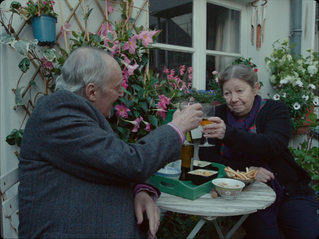An Evening With Beverly Luff Linn
- Charlotte Mansfield
- Jan 2, 2021
- 3 min read
Updated: Feb 2, 2021
Jim Hosking, 2018

An Evening With Beverly Luff Linn centres around unhappy wife Lulu Danger and her pursuit of a mysterious former lover by unusual means. Composed of an eclectic cast, saturated mise-en-scéne and blasts of mundane synths, this dreamlike world floats in ambiguity of time and place. The clothing and music is suggestive of the mid-1980s to early 90s while the setting is somewhere in washed out suburbia, yet these unknown factors make the film more enthralling, as do the events which are simultaneously bizarre and banal.

Chain-smoking Lulu – played by the inimitable Aubrey Plaza – is enchanting despite her cold assertiveness, hiding her emotional side from the men in her life and instead revealing herself through her iconic wardrobe. After being fired by her husband, she sheds her diner uniform of a red shirt, khaki trousers and wellington style boots for loungewear. Even in her depressed state, characterised by blankets and cushions, Lulu is chic in her lacy bodysuit, plush pink and green quilted jacket, floor length raincoat, and tight ring-curls. Once she begins her adventure with new acquaintance, Colin (Jermaine Clement), she is reborn, entering a scene clutching shopping bags with her red nails. While staying at the hotel where she finds Beverly, her style consists of colourful chunky knits, striped swimsuits, flounced shoulders and mini skirts. She later reveals a pale pink and brown fur coat draped over her hot pink party dress, her hues progressively brightening throughout the film.


Costume designer Christina Blackaller not only made the heroine an icon, but ensured the men in Lulu’s life appeared just as extravagant in their attire, shaping the characters as well as acting as comedic building blocks. Beverly (Craig Robinson) mostly appears in Scottish-style pink tartan suits and hats, complete with a pom pom matching his powder-blue socks. Colin starts out bland in neutral jackets and turtlenecks, but by the end is sporting a leopard print shirt and blue linen jacket along with his signature yellow-tinted aviators. Even Lulu’s crazed husband Shane Danger (Emile Hirsch) dons electric blue speedo-fit briefs, which feel suitably grotesque next to his silver-chain adorned hairy chest. He and his rag-tag friends attempt to disguise themselves in stylish yet humorously out of place wigs, which is an ongoing gag throughout the movie.


No one blinks at the relationship between Beverly and his “platonic life partner” Rodney Von Donkensteiger (Matt Berry) which further adds to the utopia-like timeless feel for the universe. Rodney too is incredibly stylish in pale coloured suits, and at one point startles Lulu wearing Beverly’s red and white striped bathing suit, flowery swimming cap and, randomly, makeup, giving him brightly-flushed cheeks, dreamy blue eyelids, high brows and a red lip.

The way these men intersect around Lulu highlights their weaknesses – jealousy, rage, violence, greed, and at the same time failing at these things and therefore at their idea of masculinity. By the end of the film, after some high-drama sequences as well as scenes that are so deliberately dull they end up hilarious, it feels like watching a prom drama for grown-ups, with eyeliner-streaked faces and alcohol in place of diner milkshakes.

Each thread of the film from set design to timing is not only awkward and offbeat but just plain weird. Certain scenarios play out as if from the imagination of a child and how they perceive the adult world from an innocent point of view, while others are more vulgar; yet all retain a softness from the visuals of each shot, and the sensitivity of the characters. This comes through in the language too; once we meet Beverly Luff Linn he exclusively speaks in grunts for the first hour of the film. While there is a peppering of “fucks” throughout used by most characters, there is also an overuse of the word “poo”, playing on childlike speech and scatological humour, further supported by a littering of fart jokes and thrusting gestures. Visually, the film appears drab and dreary toned but punctuated with pops of garish colour, again providing it with an unreal quality to support the prolonged anticipation for climaxes and gross sexual tension exhibited.










Comments